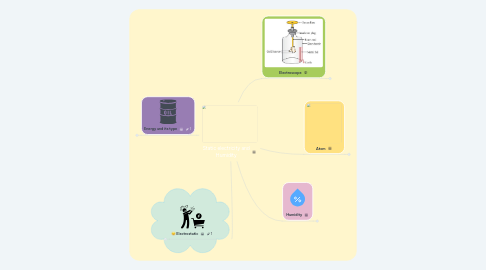
1. Atom
1.1. What is it?
1.1.1. The atom is a unit, the smallest of all, and if it is divided, it not lose its chemical properties, it is from what we are made of.
1.2. Neutrons
1.2.1. The neutron is a particle that not have charge, it is in the center of the atom.
1.3. Protons
1.3.1. The proton is a particle, have a positive charge and it is in the center of the atom. It is the heaviest
1.4. Orbits
1.4.1. The orbit is the shield of the atom were its stay the electron and it is where the electrons can change with other electrons of another atom
1.5. Electrons
1.5.1. The electron is a particle that have a negative charge and it is in the orbit of the atom.
2. Humidity
2.1. What is humidity?
2.1.1. Humidity is the amount of water vapor that is present in the atmosphere.
2.2. How its affect electrostatic?
2.2.1. All people have experienced an electric shock. This happens because of the greater amount of electrons that are discharged into the water instead of being discharged into another person.
2.3. How it is measured?
2.3.1. Humidity is measured with a measuring instrument called a hygrometer, which measures the degree of humidity.
3. Electroscope
3.1. An electroscope is an instrument that measures the electric charge of an object, it detects if there are a positive or negative charge. With this you can see if there are electrical charges and their sign.
4. Energy and its type
4.1. What is energy?
4.1.1. Energy is the ability to do work, like something moving by a force, a capacity to realize a work.
4.2. What is thermal energy?
4.2.1. Thermal energy is a type of kinetic energy by a movement like the movement of throwing an arrow.
4.3. What is electrical energy?
4.3.1. Electrical energy is an attraction, a form of energy current of electric charge.
4.4. What is mechanic energy?
4.4.1. Mechanic energy analize the movement,tranquility, repose and peace, position of an object.
5. Electrostatic
5.1. What is an electric charge?
5.1.1. Electric charge is a property of subatomic particles and is produced when they are related to each other.
5.2. What is a electrostatic discharge?
5.2.1. Is the sudden flow of electricity between two electrically charged objects caused by contact, an electrical short, or dielectric breakdown.
5.3. What is an electricity conductor?
5.3.1. In a conductor, the electric current can flow freely, in an insulator it can not.
5.4. What is an insulator?
5.4.1. Electrical insulation occurs when an element of an electrical installation is covered with a material that is not conducive to electricity.
5.5. What is electrostatic energy?
5.5.1. Electrostatic energy It is a phenomenon that is due to an accumulation of electrical charges in an object.
5.6. How electrostatics join daily life?
5.6.1. Electrostatics joins a wide variety of aspects, as in the daily life of people.
5.7. How electrostatic is generated?
5.7.1. Static electricity is produced when certain materials are rubbed against each other.

